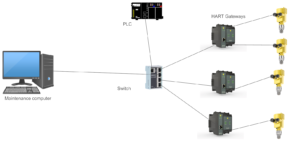Highway Addressable Remote Transducer (HART) has had a long history and is used extensively in process automation. In the early days of HART, the protocol was mainly used to set up instruments in a point-to-point manner using a HART Modem. Now, these HART instruments are being integrated into digital networks.

Figure 1: HART Instruments are connected to a Digital control system using HART to Modbus TCP Gateway. In this example, Vega instruments are connected to a maintenance computer and PLC via a Modbus TCP to HART gateway by Thorsis Technologies and a Helmholz Ethernet switch.
Benefits of Digital Deployment:
When instruments are connected to HART smart cards, the end-user has three key benefits:
- Easier access to the instrument for maintenance
- Full accuracy of the instrument
- Up to date diagnostic information
Easy Access:
Traditionally, if a maintenance person was called to look into an issue they had to go to the instrument to see what was going on. They may have taken a computer and connected to the instrument with a HART modem to see more information. Either way, this process took time.
With digital access via HART smart cards, the maintenance person can log onto the instrument from their office. They may still need to go to the instrument, but they will have a far better idea of what to bring with them. In many plants, this could easily cut ½ hour off the troubleshooting process. Given the high cost of downtime in most industries, this reduction of downtime could more than justify the initial costs of implementing such a system.
Improved Accuracy:
All instruments today have micro-processors. The process variable that they calculate is therefore represented in them as a floating-point number. When you have digital access to the instrument, you then get back the instrument’s full accuracy. No losses.
However, if you are only connected via 4-20mA, then the value has to go through a D/A converter at the instrument, then the value is transmitted and finally at the input card of the PLC or DCS, the value goes through another A/D converter. Those are three instances where accuracy can be lost. How much depends on many factors. With digital deployment, the design engineer involved does not have to be concerned with these factors.
The cost of accuracy is hard to pin down. In some applications, there would be no cost savings. However, in others, this increase of accuracy could save a lot due to increased product quality and reduced rejected products.
Up to date Diagnostic Information:
HART smart cards also supply diagnostic information. The information provided and how the cards present the information vary from smart card to smart card. This feature is also optional in many cards. Therefore, this is one feature of digitization that is dependent on the design engineers’ choices.
If the engineers choose well, the operator will know if they can trust their process variables or not, and the maintenance person will know if they need to troubleshoot an instrument. If the maintenance person needs to troubleshoot the instrument, there will also be key information provided on what is going on.
Again, the cost benefits of this will vary from case to case. However, it does not take much thinking about your application to realize that these cost savings can be substantial.
Summary:
Digital deployment holds the promise of easy access to instruments for maintenance personnel, increased accuracy and up to date device diagnostics. The full cost advantage will vary from application to application and from implementation to implementation. However, there are clear advantages for operations to take advantage of digital deployment.
This article is adapted from the information presented in ‘HART Communication Protocol – A Practical Guide’ by James Powell. Copyright 2020 by James Powell.
References:
- HART Communication Protocol – A Practical Guide’, James Powell, P.Eng., ISBN 9781655583711
- Is PROFIBUS or 4-20mA More Accurate? November 2, 2015 Tech Tips, PI PROFINEWS, ISSUE 134. (https://profinews.com/2015/11/is-profibus-or-4-20ma-more-accurate/)
